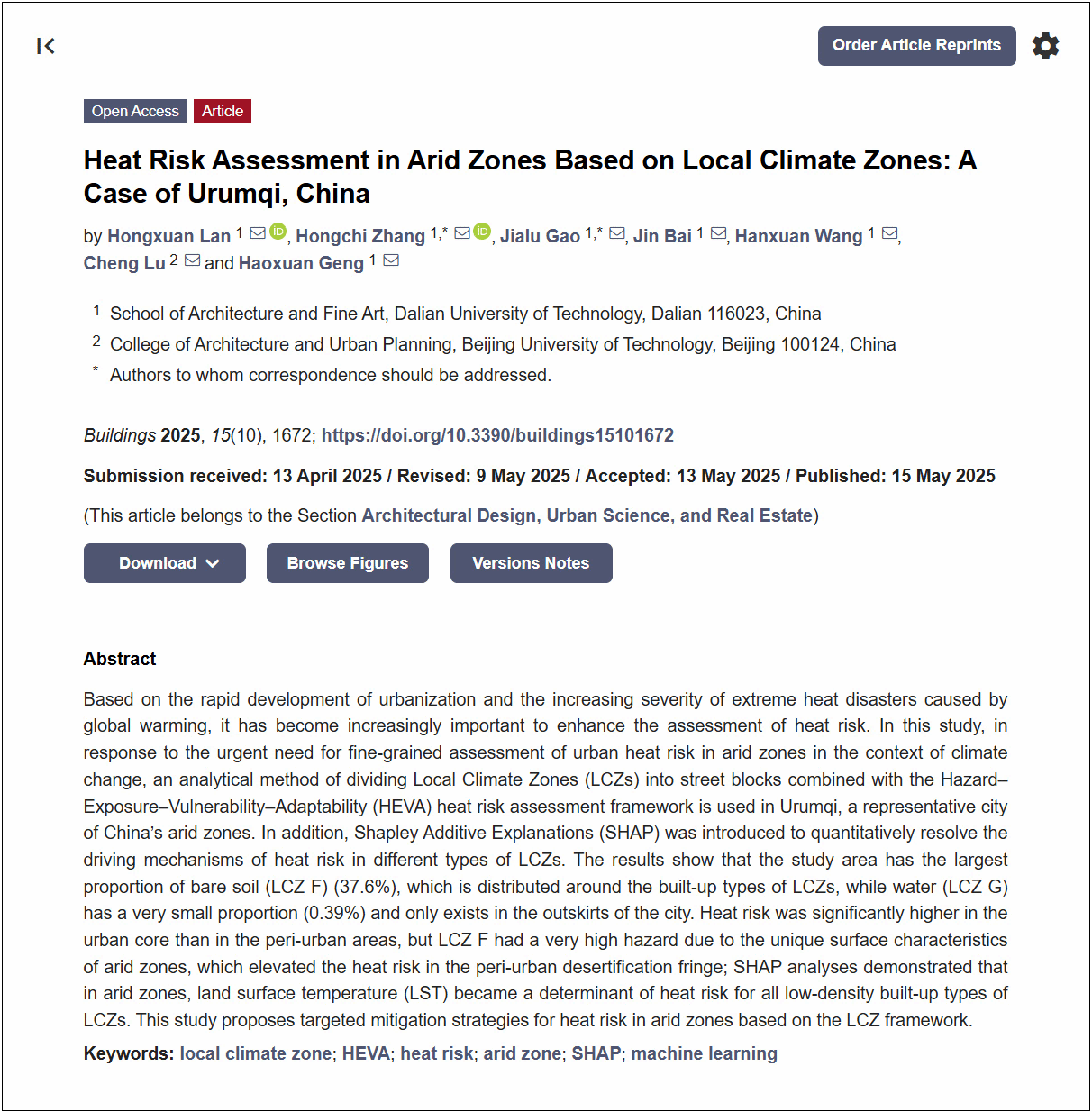近日,建筑与艺术学院建筑学专业2021级本科生蓝鸿萱(第一作者),王瀚萱,耿昊暄团队在SCI期刊《buildings》(JCR 2区,IF=3.1)发表了题为“Heat Risk Assessment in Arid Zones Based on Local Climate Zones: A Case of Urumqi, China”的研究成果,指导教师和通讯作者为张弘驰副教授。
该成果为我院本科生首次以第一作者身份在SCI期刊发表学术论文,标志着学院本科生科研科创工作取得突破。本研究受国家自然科学基金:基于局地气候分区的城市热环境评估及规划机制研究(52108044)资助。

该研究立足于建筑技术交叉学科,运用地理大数据、机器学习、遥感反演,基于建筑学街区尺度视角讨论城市环境热风险。研究成果为精细化的城市热风险评估搭建了普适性的框架,为建筑学课在气候变化这一时代课题下建设可持续发展的气候适应型城市做出了进一步探索。
建筑与艺术学院不断深化本科生人才培养改革,坚持交叉布局,强化实践锻炼。 一方面,持续强化设计基础教育,培育学生参与国内外设计竞赛并屡屡斩获佳绩;另一方面,积极响应学科前沿发展趋势,提前布局“AI+”设计,为对技术研究感兴趣的学生提供科研平台和导师指导。此次突破,正是学院并行推进设计实践与科研创新能力培养的阶段性成果。
未来,建艺学院将持续丰富人才培养体系,在巩固设计学科核心竞争力的同时,深化前沿技术研究与设计实践的交叉融合,为培养“全面发展、分类卓越、多元成才”的大工建艺人提供更广阔的平台!
论文摘要:Based on the rapid development of urbanization and the increasing severity of extreme heat disasters caused by global warming, it has become increasingly important to enhance the assessment of heat risk. In this study, in response to the urgent need for fine-grained assessment of urban heat risk in arid zones in the context of climate change, an analytical method of dividing Local Climate Zones (LCZs) into street blocks combined with the Hazard–Exposure–Vulnerability–Adaptability (HEVA) heat risk assessment framework is used in Urumqi, a representative city of China’s arid zones. In addition, Shapley Additive Explanations (SHAP) was introduced to quantitatively resolve the driving mechanisms of heat risk in different types of LCZs. The results show that the study area has the largest proportion of bare soil (LCZ F) (37.6%), which is distributed around the built-up types of LCZs, while water (LCZ G) has a very small proportion (0.39%) and only exists in the outskirts of the city. Heat risk was significantly higher in the urban core than in the peri-urban areas, but LCZ F had a very high hazard due to the unique surface characteristics of arid zones, which elevated the heat risk in the peri-urban desertification fringe; SHAP analyses demonstrated that in arid zones, land surface temperature (LST) became a determinant of heat risk for all low-density built-up types of LCZs. This study proposes targeted mitigation strategies for heat risk in arid zones based on the LCZ framework.
文章链接:https://doi.org/10.3390/buildings15101672